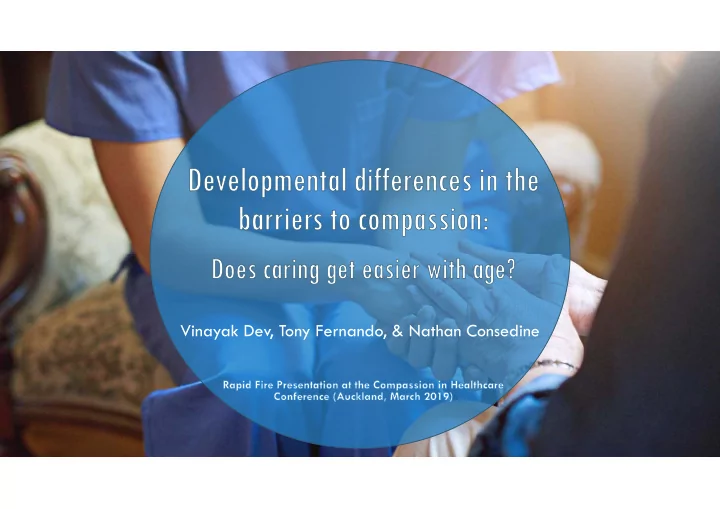

Vinayak Dev, Tony Fernando, & Nathan Consedine
WHY BOTHER? Compassion is ‘a cornerstone for quality healthcare’ Predicts greater work-related pleasure – ‘compassion satisfaction’ For patients, compassion predicts: lower anxiety better relationships greater healthcare satisfaction improved recovery greater responsibility and control
THE DEVELOPMENTAL QUESTION If compassion fatigue results from the “draining” of care, then why: is compassion fatigue lower in older physicians and nurses? do younger clinicians report greater burnout and lower satisfaction? Practically, we can wonder: whether such differences are reflected in barriers to compassion? what younger carers can learn from more experienced carers
AN INITIAL STUDY
STUDY METHODS OUTLINE Participants: 1,700 health professionals (and trainees) Samples to date: 801 nurses 383 medical students 516 New Zealand doctors 378 Filipino doctors (not included in the published manuscript) Procedure: Online surveys, convenience sampling in NZ and the Philippines Measures: Predictors: Training/profession Confounds: Demographics, work characteristics, burnout Outcomes: Barriers to compassion
UNIVARIATE CORRELATIONS Greater experience = Greater workload BUT lower burnout and lower barriers to compassion Students have lower workload than nurses and physicians, BUT generally report greater barriers
COMPARISONS (STUDENTS VS PHYSICIANS) Physicians Medical Students [VALUE]0 3.75 Medical students reported 3.36 [VALUE]0 3.11 2.99 greater scores than 2.83 Means 2.54 experienced physicians across ALL barriers BURNOUT-RELATED ENVIRONMENTAL PATIENT AND FAMILY- CLINICAL RELATED Barriers to Compassion
Relative to more experienced physicians, medical students reported greater burnout-related, environmental, and clinical barriers to compassion, but NOT patient and family-related barriers.
RELATIONS BETWEEN EXPERIENCE & BARRIERS Pearson’s r Correlations Between 0.22 0.21 0.19 Experience and Barriers Overall, greater experience was 0.11 associated with lower barriers across all -0.07 -0.03 professional samples – i.e., NZ and -0.10 Filipino doctors, and nurses. -0.20 -0.21 -0.21 -0.24 -0.25 -0.27 -0.30 BUT, in medical students, experience was -0.33 Burnout-related -0.39 associated with greater barriers. Environmental Patient and family-related Clinical NZ DOCTORS FILIPINO DOCTORS NURSES MEDICAL STUDENTS Barriers to Compassion
KEY FINDINGS/INTERPRETATIONS Barriers to compassion generally lower with greater clinical experience Effect evident in multiple samples Possible explanations (thus far): 1. Attrition, retirement, differential job change – ‘the mean doctors leave’ 2. Cohort effects – ‘carers trained in different times “work” differently’ 3. Professional and individual development – ‘something changes over time’ a) A seniority effect? Greater autonomy? b) Less prone to judgement? An “I’ve-seen-worse” effect? c) Developmental changes in emotion regulation?
THAT’S ALL FROM ME; BUT:
THANK YOU! You can follow our work in this area (and us) on Twitter: Vinayak (Vinny) Dev Twitter handle: @vinayakdev_ Antonio (Tony) Fernando III Twitter handle: @tonyfernando3rd Nathan Consedine Twitter handle: @nathanconsedine
REFERENCES Advisory Board. (2016). Survey: Many doctors looking to leave profession amid burnout, low morale. Retrieved from https://www.advisory.com/daily- briefing/2016/09/26/doctors-leaving-profession?wt.mc_id=email%7Cdailybriefing+headline%7Cdba%7Cdb%7C2016sep23%7Catestdb2016sep26%7C%7C%7C%7C Crawford, R. L., & McCormack, R. C. (1971). Reasons physicians leave primary practice. Academic Medicine, 46, 263-268. Retrieved from https://journals.lww.com/academicmedicine/Abstract/1971/04000/Reasons_physicians_leave_primary_practice.1.aspx Dev, V., Fernando, A. T., Kirby, J. N., & Consedine, N. S. (2019). Variation in the barriers to compassion across healthcare training and disciplines: A cross-sectional study of doctors, nurses, and medical students. International Journal of Nursing Studies, 90, 1-10. doi:10.1016/j.ijnurstu.2018.09.015 Douglas, H. (2017). Why are women leaving medicine? Retrieved from http://www.medicaleconomics.com/medical-economics-blog/why-are-women-leaving-medicine Fernando, A. T., & Consedine, N. S. (2017). Barriers to medical compassion as a function of experience and specialization: Psychiatry, pediatrics, internal medicine, surgery, and general practice. Journal of Pain and Symptom Management, 53, 979-987. doi:10.1016/j.jpainsymman.2016.12.324 Gaitniece-Put ā ne, A. (2006). Gender and age differences in emotional intelligence, stoicism and aggression. Baltic Journal of Psychology, 7, 26-42. Retrieved from http://dspace.lu.lv/dspace/bitstream/handle/7/1315/BalticJournPsychol-2006-Vol-7_No-2.pdf?sequence=1&isAllowed=y#page=26 Griffiths, S., & Corke, J. (2017). 300 student doctors quit university each year. Retrieved from https://www.thetimes.co.uk/article/300-british-student-doctors-quit-university-each- year-7p8q697vz Jefferson, L., Bloor, K., & Maynard, A. (2015). Women in medicine: Historical perspectives and recent trends. British Medical Bulletin, 114, 5–15. doi:10.1093/bmb/ldv007 Jonassen, D., Spector, M. J., Driscoll, M., Merrill, M.D., & van Merrienboer, J. (2008). Handbook of research on educational communications and technology: A project of the association for educational communications and technology. Abingdon, United Kingdom: Routledge. Papadimos, T. J. (2004). Stoicism, the physician, and care of medical outliers. BMC Medical Ethics, 5, 8-15. doi:10.1186/1472-6939-5-8 Ramakrishnan, A., Sambuco, D., & Jagsi, R. (2014). Women's participation in the medical profession: insights from experiences in Japan, Scandinavia, Russia, and Eastern Europe. Journal of Women's Health, 23, 927-934. doi:10.1089/jwh.2014.4736 Silvers, J. A., McRae, K., Gabrieli, J. D., Gross, J. J., Remy, K. A., & Ochsner, K. N. (2012). Age-related differences in emotional reactivity, regulation, and rejection sensitivity in adolescence. Emotion, 12, 1235–1247. doi:10.1037/a0028297 Spector, N. (2018). The doctor is out? Why physicians are leaving their practices to pursue other careers. Retrieved from https://www.nbcnews.com/business/business-news/doctor- out-why-physicians-are-leaving-their-practices-pursue-other-n900921 Urry, H. L., & Gross, J. J. (2010). Emotion regulation in older age. Current Directions in Psychological Science, 19, 352-357. doi:10.1177/0963721410388395 Yong, H. H., Gibson, S. J., Horne, D. J., & Helme, R. D. (2001). Development of a pain attitudes questionnaire to assess stoicism and cautiousness for possible age differences. The Journals of Gerontology Series B: Psychological Sciences and Social Sciences, 56, 279-284. doi:10.1093/geronb/56.5.P279
Recommend
More recommend